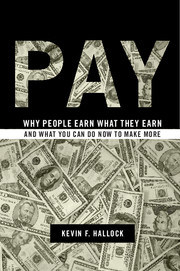Book contents
- Frontmatter
- Contents
- Figures
- Tables
- Acknowledgments
- PART I HOW HARD CAN THIS BE?
- PART II HOW ORGANIZATIONS SET PAY STRUCTURE AND WHY
- PART III HOW PEOPLE ARE PAID CAN MEAN AS MUCH AS HOW MUCH THEY ARE PAID
- 9 Evaluating Performance, Incentives, and Incentive Pay
- 10 Stock and Stock Options
- 11 Pay Mix
- 12 International Compensation
- 13 Compensation in Nonprofit Organizations
- PART IV WHAT YOU CAN DO TO MAKE MORE AND CONCLUDING COMMENTS
- Notes
- References
- Index
13 - Compensation in Nonprofit Organizations
from PART III - HOW PEOPLE ARE PAID CAN MEAN AS MUCH AS HOW MUCH THEY ARE PAID
Published online by Cambridge University Press: 05 October 2012
- Frontmatter
- Contents
- Figures
- Tables
- Acknowledgments
- PART I HOW HARD CAN THIS BE?
- PART II HOW ORGANIZATIONS SET PAY STRUCTURE AND WHY
- PART III HOW PEOPLE ARE PAID CAN MEAN AS MUCH AS HOW MUCH THEY ARE PAID
- 9 Evaluating Performance, Incentives, and Incentive Pay
- 10 Stock and Stock Options
- 11 Pay Mix
- 12 International Compensation
- 13 Compensation in Nonprofit Organizations
- PART IV WHAT YOU CAN DO TO MAKE MORE AND CONCLUDING COMMENTS
- Notes
- References
- Index
Summary
Even though an extremely large number of people work in the nonprofit sector, surprisingly little is known about how people there are compensated, relative to what we know about the for-profit sector. This chapter aims to fill this gap by presenting a simple description of the employees in the nonprofit sector and describing some differences in the pay of those in the nonprofit, for-profit, government, and self-employed sectors. The chapter also discusses different kinds of nonprofits, the size of the sector, and possible reasons why people in the nonprofit sector are paid differently than those in the for-profit sector. These reasons include: labor donations (some argue that workers in nonprofits are effectively making donations to their organizations in the form of lower wages), compensating differentials (some have argued that workers in nonprofits accept lower wages in exchange for better working conditions, more job flexibility, etc.), and differences in returns to characteristics or selection (some have suggested that perhaps different kinds of workers choose to work in the nonprofit sector). The chapter also discusses gender in the context of nonprofits and includes a discussion of managerial compensation in nonprofit organizations.
Before considering differences in the way those in the nonprofit and for-profit sectors are paid, this section provides a brief outline of the nonprofit sector in general. In this section, I define the nonprofit sector, explain simple details of the structure of the nonprofit sector, and describe Hansmann's (1980) “nondistribution constraint.” This constraint is central to organizations’ choice of the nonprofit form, as well as the pay gaps and issues of incentive compensation discussed later. The nonprofit “industry” classification system, the National Taxonomy of Exempt Entities (NTEE), is also explained later in the chapter.
- Type
- Chapter
- Information
- PayWhy People Earn What They Earn and What You Can Do Now to Make More, pp. 152 - 184Publisher: Cambridge University PressPrint publication year: 2012

